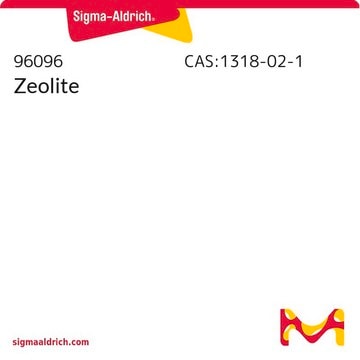562599
Cäsiumchlorid
99.99% trace metals basis
Synonym(e):
Cesium monochloride
About This Item
Empfohlene Produkte
Assay
99.99% trace metals basis
Form
powder
Verunreinigungen
≤150.0 ppm Trace Metal Analysis
mp (Schmelzpunkt)
645 °C (lit.)
SMILES String
[Cl-].[Cs+]
InChI
1S/ClH.Cs/h1H;/q;+1/p-1
InChIKey
AIYUHDOJVYHVIT-UHFFFAOYSA-M
Suchen Sie nach ähnlichen Produkten? Aufrufen Leitfaden zum Produktvergleich
Allgemeine Beschreibung
Anwendung
- As a precursor to fabricate homogeneous perovskite films with high crystallinity and preferential orientation. These films enhance the power conversion efficiency of solar cells.
- To synthesize blue emission lead-free antimony Cesium halide Qdots of high PLQY of 46% and Mn-Doped Cs2Na1–xAgxBiCl6 double perovskites for engineering the band gap and tailoring the energy transfer.
- To fabricate polyoxometalate electrode materials for Li-ion batteries. The addition of CsCl enhances the thermal stability and cycling stability of the battery cell.
- To prepare a density gradient solution for the separation of nucleic acids.
Signalwort
Warning
H-Sätze
Gefahreneinstufungen
Repr. 2
Lagerklassenschlüssel
13 - Non Combustible Solids
WGK
WGK 1
Flammpunkt (°F)
Not applicable
Flammpunkt (°C)
Not applicable
Persönliche Schutzausrüstung
Eyeshields, Gloves, type N95 (US)
Analysenzertifikate (COA)
Suchen Sie nach Analysenzertifikate (COA), indem Sie die Lot-/Chargennummer des Produkts eingeben. Lot- und Chargennummern sind auf dem Produktetikett hinter den Wörtern ‘Lot’ oder ‘Batch’ (Lot oder Charge) zu finden.
Besitzen Sie dieses Produkt bereits?
In der Dokumentenbibliothek finden Sie die Dokumentation zu den Produkten, die Sie kürzlich erworben haben.
Kunden haben sich ebenfalls angesehen
Artikel
Colloidal quantum dots (CQDs) are semiconducting crystals of only a few nanometers (ca. 2–12 nm) coated with ligand/surfactant molecules to help prevent agglomeration.
Unser Team von Wissenschaftlern verfügt über Erfahrung in allen Forschungsbereichen einschließlich Life Science, Materialwissenschaften, chemischer Synthese, Chromatographie, Analytik und vielen mehr..
Setzen Sie sich mit dem technischen Dienst in Verbindung.





